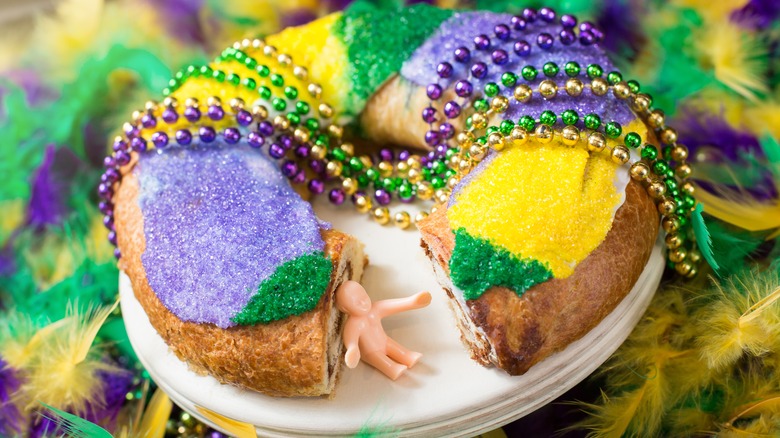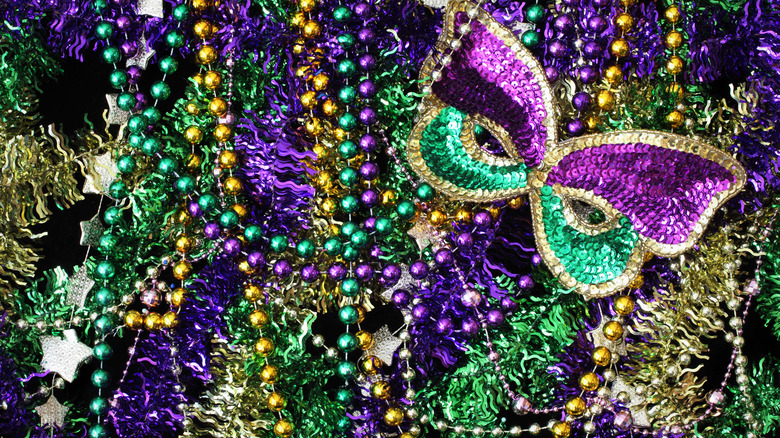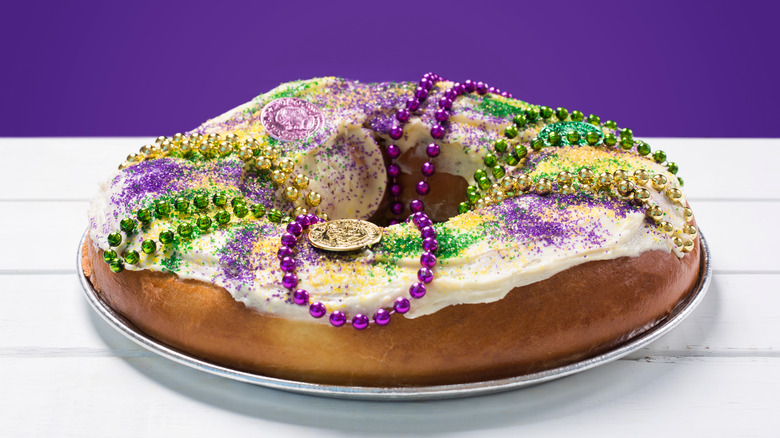The Layered Symbolism Behind Mardi Gras King Cake
Around Mardi Gras, a popular delicacy can be found in New Orleans called king cake — it's a colorful pastry ring with a small figurine of a baby baked inside. Similar seasonal pastries are also sold in Europe and Latin America, but the traditions associated with king cake are unique to the American city and its famed celebrations.
So what is king cake, and why is there a baby inside? This sweet pastry is made with brioche dough and features both delicious fillings (cinnamon, cream cheese, or chocolate are common) as well as sugary toppings that may include icing and sprinkles in traditional Mardi Gras colors like green, purple, and gold. The shape of the cake and the hidden prize inside are all symbolic, of course, and tied to seasonal celebrations in the Christian faith season in which Mardi Gras takes its roots.
For example, the cake is circular because the Mardi Gras season begins on what's known as the Epiphany aka Three Kings' Day, when the three kings (or wise men) were forced to follow a circuitous path to the Baby Jesus to avoid detection by King Herod. The figure baked inside the cake represents the Christ Child. In New Orleans lore, the person who finds the baby figure in their cut piece of cake also symbolically becomes king that day and is expected to pay for the next party, thus carrying on the Mardi Gras celebration.
Is king cake only enjoyed on Mardi Gras?
To understand this special holiday, it's important to know there's Mardi Gras, and then there's the Mardi Gras season (aka Carnival). The former is one day, while the latter covers the month-long-plus period from the Christian holiday of Epiphany on January 6 through Fat Tuesday, which is February 13 in 2024. Mardi Gras itself it celebrated on Fat Tuesday, which is the final day leading up to Ash Wednesday, and thus marks the beginning of Lent.
This same month-long time period is the traditional season for eating king cake in New Orleans. These cakes are sold at local bakeries all throughout NOLA during this period of seasonal Mardi Gras feasting. In fact, it was a local bakery, McKenzie's, that was credited with initiating the tradition of baking in the figure of the Baby Jesus in the 1950s. Before that, king cakes contained different prizes, which evolved through the years and included at various times a bean, pecan, coin, or ring.
The idea that the person finding the prize becomes king for a day is also symbolic, of course, and dates back to ancient pagan celebrations in which a member of the community was sacrificed to ensure a bountiful harvest. Before his death, however, the martyr was declared king for a day. To determine who would be given this honor, a cake was baked with a prize inside, typically a bean or a coin.
How to make Mardi Gras king cake at home
Unless you live in and around New Orleans, it may be difficult to find a king cake at your local bakery. However, that doesn't mean you can't start your own delicious Mardi Gras tradition at home. Some bakeries will ship the cakes anywhere in the U.S. but these treats can also be made in your own kitchen.
If you're looking for a twist on the classic, try this bananas foster king cake that comes together in just over an hour. Just don't forget to add the plastic baby figure. It's not a king cake without one, due to the symbolic values it represents.
It's also important to add colorful icing or sprinkles, as these, too have symbolic meanings. The Mardi Gras colors of green, purple, and gold each stand for a different iconic value: Green epitomizes faith, while purple represents justice and gold is power.
Static Media owns and operates Food Republic and Tasting Table.



